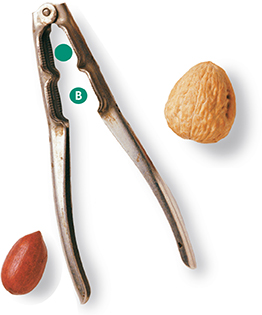14.3 Mechanical Advantage and Efficiency
Reading Focus
Key Concepts
 How does the actual mechanical advantage of a machine compare to its ideal mechanical advantage?
How does the actual mechanical advantage of a machine compare to its ideal mechanical advantage? Why is the efficiency of a machine always less than 100 percent?
Why is the efficiency of a machine always less than 100 percent?
Vocabulary
mechanical advantage
actual mechanical advantage
ideal mechanical advantage
efficiency
Reading Strategy
Building Vocabulary Copy the table below. Then as you read the section, write a definition for each vocabulary term in your own words.
Vocabulary |
Definition |
|---|---|
Mechanical advantage |
a. |
b. |
c. |
d. |
e. |
f. |
g. |
Try cracking a walnut by squeezing it in your hand. You'll find that you can't apply enough force to break the shell. Next try cracking the shell using a nutcracker. A nutcracker, which is a type of machine, is shown in Figure 9. If you squeeze the nutcracker near its pivot end, you still won't be able to crack the nut. When you squeeze the ends of the handles, however, a fairly small force cracks the shell apart. In this section you'll learn why a machine like the nutcracker is so sensitive to the location of the input force.
Figure 9 A nutcracker is a machine capable of converting the input force applied to it into a larger force capable of cracking a nut. Because it increases force, the nutcracker has a mechanical advantage greater than 1. Inferring What might be the reason that the nutcracker has two different areas (A and B) to use for nut cracking?

Mechanical Advantage
The relation of input force used to operate a machine and the output force exerted by the machine depends on the type of machine and how it is used. Thus the location of the nut in the nutcracker affects the force the nutcracker is able to exert.
The mechanical advantage of a machine is the number of times that the machine increases an input force. Suppose a nut is in the nutcracker at position A in Figure 9. In this position the nutcracker exerts a force on the nut about seven times greater than the force you exert on the nutcracker. In position A the nutcracker's mechanical advantage is about 7. However, if the nut is moved to position B, the mechanical advantage decreases to about 3.






